Texas has a diverse landscape and a long season for beetles. Many native and introduced species are found in the Eastern and Southern parts of the state.
Some of the beetles here are predatory, acting as biological control agents against invasive scale bugs and similar species.
Other types of beetles are borers. These types of beetles might even bore into live wood, leading to slow tree death.
The hot climate of the state also means many beetles here stay hidden during the day, which may seem like there’s a reduced number of beetles here.
Found across different counties, Texas beetles may be spotted in gardens. They often live in woodlands or areas around water.
Some species of beetles in Southern Texas also live in sandy arid areas.
Most types of beetles here have a very specific diet. They can be tree borers, bugs that eat pollen, or predators.
A wider number of species also have a diverse diet, eating both plants and insects.
Here are 54 species of beetles in Texas and the most common areas they can be spotted in.
Table of Contents
1. Asian Ladybug

Scientific name: Harmonia axyridis
First introduced to Texas in the ‘60s, Asian Ladybugs are now one of the most common beetles of the state.
These predatory bugs have been introduced to control agricultural pests and they were found in the Southern parts of the state for years, before spreading out.
The main role of the species was to act as a natural biological control agent and kill the pest species on crops and trees of the state.
Aphids and mites are among the most common species controlled by The Asian Ladybug. A single bug of this species eats thousands of bugs such as aphids in its lifetime.
Distribution area – throughout the state
2. Seven-spotted Ladybug

Scientific name: Coccinella septempunctata
The Severn-spotted Ladybug is another introduced species in Texas up to the ‘90s. This type of bug is also a biological control agent, similar to The Asian Ladybug.
Named after the seven black spots on its red elytra, this type of bug has an appetite for aphids.
It feeds on tens of aphids per day, clearing out invaded gardens and crops throughout the state.
The species tends to move around to areas with aphids and mites, which means it can cover crops in most areas of the state.
Now declining in numbers in its native range of Europe, Seven-spotted Ladybugs are increasing in populations across Texas.
Distribution area – throughout Texas
3. Spotted Cucumber Beetle

Scientific name: Diabrotica undecimpunctata
Spotted Cucumber Beetles are known as Southern Corn Rootworms in their native Texas range.
These beetles are also known as The Mexican Corn Rootworm in the Southern parts of Texas.
This species often live on cucumbers and it is recognized by its yellow color with 12 black spots.
Beetles of this genus are considered pests of cucumbers. They are also found on other crops where they eat the leaves of various species such as soybean and squash.
Distribution area – throughout the state
4. Convergent Ladybug

Scientific name: Hippodamia convergens
Found in different areas of the state, The Convergent Ladybug is a common beetle with 2 broods per year.
This type of beetle is named after the white converging lines on its prothorax.
Its body is mostly red on adults and possibly orange on young beetles.
Convergent Ladybugs tend to eat aphids, especially in the case of females who need to lay eggs.
Males also eat aphids but may consider eating pollen or honeydew when aphids aren’t found.
Distribution area – throughout the state
5. Spotless Ladybug

Scientific name: Cycloneda sanguinea
The Spotless Ladybug is among the typical species of Texas with red elytra. Orange elytra coloring is also specific to The Spotless Ladybug.
Known for its black and white thorax, this species rarely has a vivid red color, as its elytra have a darker red appearance.
Spotless Ladybugs feed on aphids that live on milkweeds around the state. It helps control small aphid populations
Distribution area – Central Texas
6. Ashy Gray Ladybug

Scientific name: Olla v-nigrum
The Ash Gray beetle is a species with a bright gray or white color.
Its elytra and prothorax have the same color, exhibiting multiple black spots arranged in different patterns.
The species is one of the smaller ladybugs in the state, with a maximum size of just 0.1 inches.
A black and yellow appearance is specific to the larva of the species.
Distribution area – Fort Worth and Central Texas
7. Common Green June Beetle

Scientific name: Cotinis nitida
The Common Green June Beetle is one of the species causing economic losses across Texas vineyards and other similar regions.
Grapes and other fruits in the state are highly impacted by this species.
This species has a distinct green appearance. It has a metallic green body with additional orange or yellow sections.
Distribution area – North Texas, East Texas
8. Kern’s Flower Scarab

Scientific name: Euphoria kernii
Fields and meadows around central and Western Texas are among the ideal location for the Kern’s Flower Scarab to find flowers to feed on.
This species eats the pollen of different flowers. Some irises and a few wild rose species have been indicated as ideal hosts for the species.
A mostly black body with brown, tan, or gray elytra edges is characteristic of this species.
Distribution area – Dallas areas
9. Texas Ironclad Beetle

Scientific name: Zopherus nodulosus
The Texas Ironclad Beetle is a typical species in the Southern range of the state where it can be spotted laying eggs on trees.
Some of the favorite trees for the female Texas Ironclad Beetle to lay eggs on includes The American Elm.
A contrasting black-and-white appearance is specific to the species.
Damages to trees are minimal to non-existent as these beetles prefer to fee don lichen.
Distribution area – Southern and Southwestern Texas
10. Six-spotted Tiger Beetle

Scientific name: Cicindela sexguttata
The Six-spotted Tiger Beetle is one of the tens of Cicindela bugs in Texas.
Considerably different from all other members of this family, The Six-spotted Tiger Beetle has a distinct metallic green color and contrasting long black legs.
Its name is derived from the 6 spots or marks along its body.
A long-living species, The Six-spotted Tiger Beetle lives up to 3 years.
Distribution area – East Texas
11. Horned Passalus Beetle

Scientific name: Odontotaenius disjunctus
A common species in Eastern North America, The Horned Passalus Beetle is also present in Texas, its Southwestern limit.
Growing to a size of up to 1.6 inches, The Horned Passalus Beetle is among the few beetles in the state feeding on wood.
It needs decaying wood, preferably oak, to survive.
Some of the fallen oak or elm woods on the woodlands floor or around gardens may have fungi growing on them. These are the types of wood The Horned Passalus Beetle can digest.
Distribution area – East Texas
12. Texas Flower Scarab

Scientific name: Trichiotinus texanus
This type of beetle is found throughout Texas, especially in the central parts of the state.
As a herbivorous species, the beetle only feeds on flower pollen. Native wildflowers such as The Texas Thistle are among its most common foods.
While this flower is purple, the scarab is almost completely black.
It stands out immediately on Texas Thistle but it also feeds on the pollen of other local purple wildflowers such as The Purple Poppymallow.
Distribution area – San Antonio to Dallas
13. Texas Eyed Click Beetle
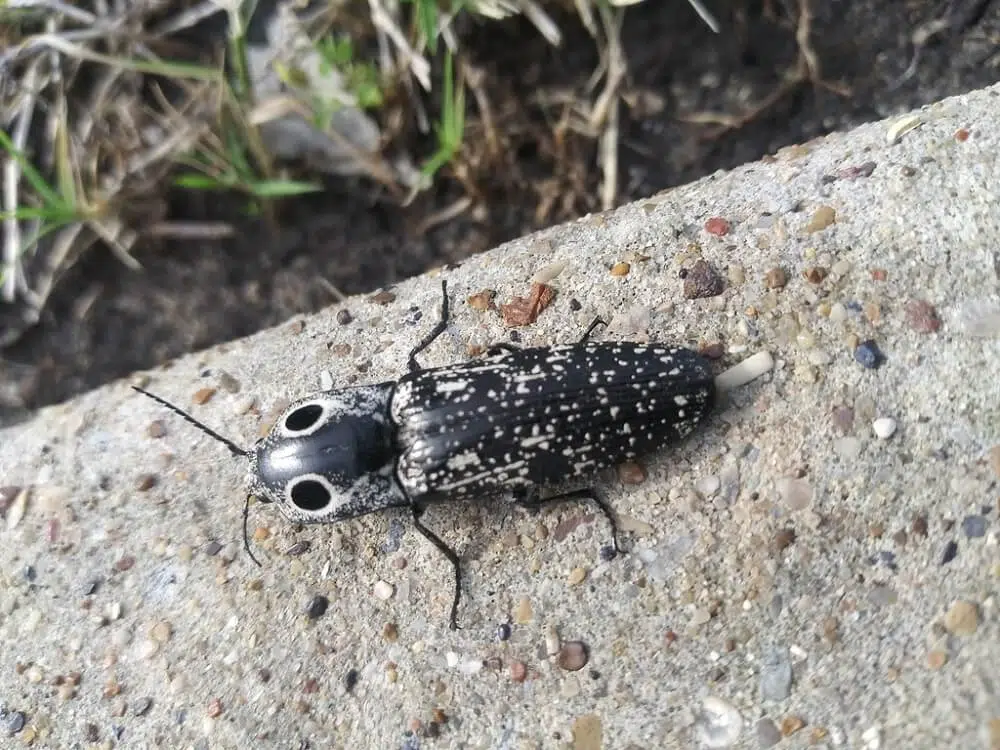
Scientific name: Alaus lusciosus
This type of beetle is a true omnivorous species with a contrasting black-and-white or black-and-yellow appearance.
2 large black eyespots inspire the name of the species. These eyespots aim to confuse predators when it comes to their exact species.
Texas Eyed Click Beetles can sometimes be spotted in gardens. This is a species that feeds on pollen and invasive aphids.
While it doesn’t bite, the beetle can jump very high.
Distribution area – Central, Southern Texas, and Eastern Texas
14. Dark Flower Scarab

Scientific name: Euphoria sepulcralis
This dark type of beetle is present in Texas and in many other Southern US states.
It features a black color with brown or tan mottling along its elytra and a dangerous status to local crops.
Dark Flower Scarabs feed on corn. They also feed on the pollen of different wildflowers such as milkweed, daisies, or yarrow.
Some of the less common sources of nectar for the species also include shrubs such as black cherry.
Distribution area – Southern and Eastern Texas
15. Aloeus Ox Beetle

Scientific name: Strategus aloeus
This type of brown beetle is a common occurrence in Texas. It has a born body and distinct horns which make it similar to a rhinoceros.
These horns are seen on males which use them to fight other males.
The Aloeus Ox Beetle is among the typical species in the state of Texas to have a presence in different areas of the state.
It requires food such as the roots of wildflowers for its larvae. Once it reaches adulthood, The Aloeus Ox Beetle starts to eat fruit and flowers
Distribution area – Southern Texas, Eastern Texas
16. Fiery Searcher Beetle

Scientific name: Calosoma scrutator
Multiple state counties are home to this colorful species of beetle. The Fiery Searcher Beetle is a species that can climb, but its coloring is what sets it apart.
It has a metallic green main color and neon blue legs. Some members of this species are also spotted in black legs’ coloring.
Not very common outside of Texas, this species has different types of defensive mechanisms.
Releasing a foul-smelling oil is one of the first reactions of the bug when picked up.
Distribution area – Eastern Texas
17. Hardwood Stump Borer

Scientific name: Mallodon dasystomus
This type of stump borer is present across Southern US states, including Texas. Its range expands to Florida and the species is a known beetle around dead wood.
Its larvae are dangerous to local trees as it bores in them. Various species of oak as well as pecan and willow are all impacted by the beetle.
A common color of the species is black, together with a less common dark brown.
Hardwood Stump Borers grow to a size between 1.2 and 1.9 inches.
Distribution area – Southern Texas, Eastern Texas.
18. Varied Carpet Beetle

Scientific name: Anthrenus verbasci
The Varied Carpet Beetle can be found in most areas of the state but it is abundant in areas with vegetation and around inhabited areas.
This species feeds both on pollen and on animal-based products. It enters the home by accident or on purpose, where it can feed on various natural fibers.
Varied Carpet Beetles are among the species that have colorful bodies. This beetle has white, yellow, and brown colors, with some individuals also showing black patterns.
This species may be long-living in Texas, as it can survive up to 3 years.
Distribution area – Houston, Dallas, and most other urban regions
19. Common Eastern Firefly

Scientific name: Photinus pyralis
The Common Eastern Firefly is a typical beetle with a size of up to 2 inches.
This species has an all-black color with a slightly shiny exoskeleton. It lives in a large habitat in Texas but it is not as present in the state as in Mexico or other South American habitats.
The larvae of The Common Eastern Firefly are the most troublesome. It bores into different trees, mostly live trees.
Oak, elm, and other hardwood trees in Texas can be impacted by The Common Eastern Firefly larvae.
Distribution area – Southern Texas
20. Gazelle Scarab

Scientific name: Digitonthophagus gazella
Gazelle Scarabs are among the smallest introduced species in Texas. This is a species that feeds on dung and this means it also controls all parasites spread to livestock through dung.
A typical Gazelle Scarab doesn’t measure more than 0.5 inches. It has uniform brown or black coloring and can be found in area areas of the state.
When brown, this introduced species also shows brown-golden margins.
Distribution area – throughout Texas
21. Shiny Flea Beetle
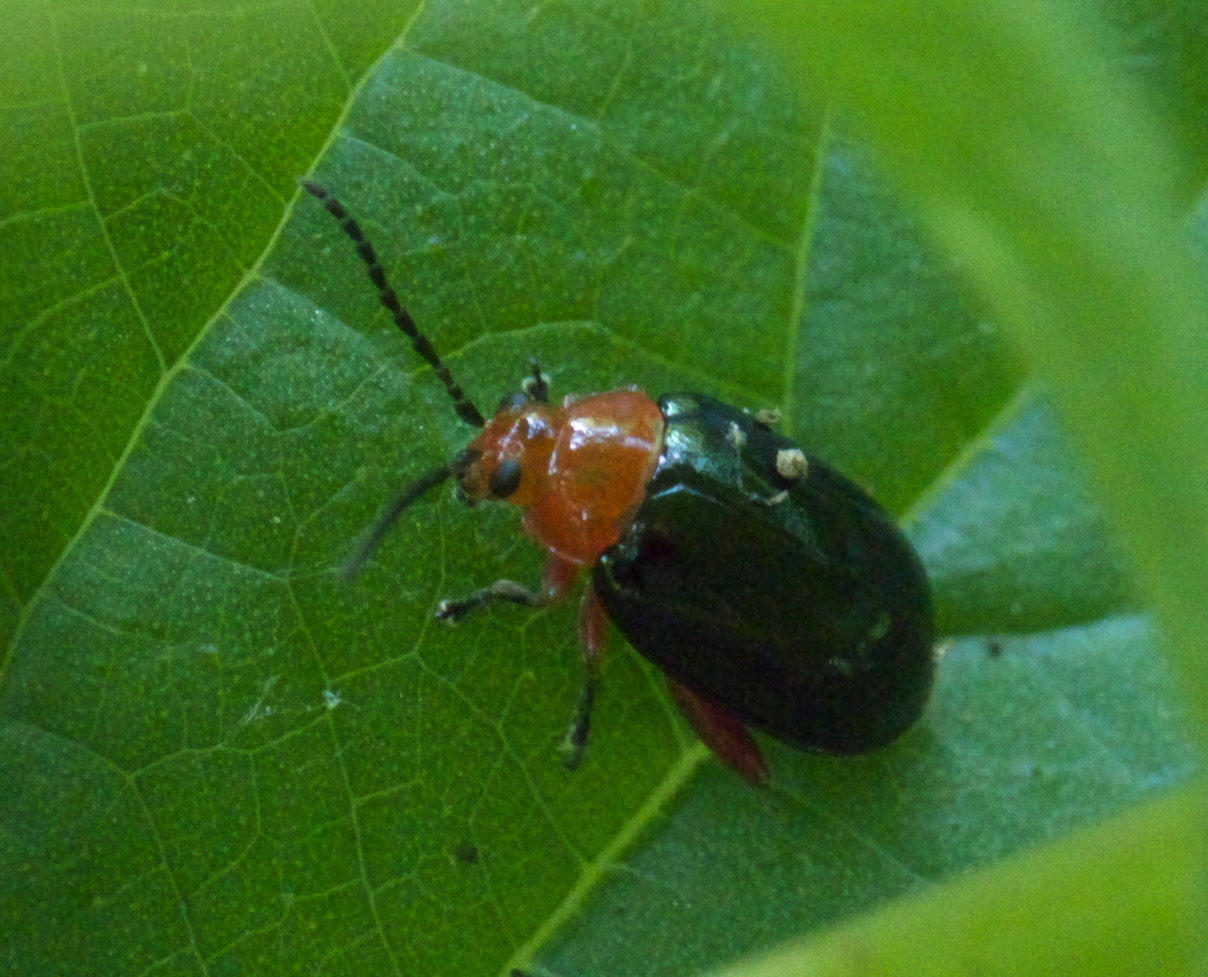
Scientific name: Asphaera lustrans
This type of flea beetle is one of the smallest types of herbivorous beetles in Texas.
Adult Shiny Flea Beetles measure between 0.2 and 0.3 inches.
They have a black and red or black and brown shiny body and feed on different types of plants, depending on their regions in the state.
Most Shiny Flea Beetles in Texas feed on Skullcap. Those in Central Texas are known for feeding on poisonbean. This is a type of wild legume with poisonous seeds.
Distribution area – Southeastern Texas, Southern Texas
22. Punctured Tiger Beetle

Scientific name: Cicindela punctulata
Punctured Tiger Beetles are adapted to living in sandy areas and the Southern parts of Texas.
This species is seen in green or dark brown coloring with spots. Its metallic green morph is contrasted by white dots while its brown morph is contrasted by green or white dots.
Growing up to a size of 1 inch, this species has up to 2 years, sometimes less.
Punctured Tiger Beetles aren’t active throughout the year as they prefer to become almost completely inactive towards the end of the year.
Distribution area – Southern Texas
23. Ocellated Tiger Beetle

Scientific name: Cicindela ocellata
The Ocellated Tiger Beetle has a dark gray or brown color with or without white spots. A common appearance with 8 white spots is seen for the species.
Ocellated Tiger Beetle larvae are known for being aggressive. It eats insects and it may even attempt to bite when handled.
The adult Ocellated Tiger Beetle can be seen on sandy areas of the state just before the evening.
Distribution area – Southern Texas
24. Cottonwood Borer

Scientific name: Plectrodera scalator
The Cottonwood Borer is one of the most problematic types of invasive beetles in Central Texas.
This species is found along streams, ideal locations for trees such as cottonwood and willow.
Young trees are preferred by the beetle which is a borer. It tunnels through these trees, sometimes killing them completely or at least leading to stunting growth.
Proper management techniques against The Cottonwood Borer are difficult to establish since this species is mostly living undetected. It can take up to 5 years for it to complete its lifecycle.
Distribution area – streams of Central Texas
25. Banded Hickory Borer

Scientific name: Knulliana cincta
The Banded Hickory Borer is a species of native beetle in Texas and nearby states. It also lives in nearby regions of Mexico.
This species is named after it tends to bore into hickory. However, Banded Hickory Borers also impact other hardwood trees such as walnut and pecan.
While the borer has a short season up to October, it can still negatively impact the growth of young hardwood trees.
It may sometimes be found around the house as these types of beetles fly toward the light at night.
Distribution area – Central Texas, Northern Texas
26. Carolina Metallic Tiger Beetle

Scientific name: Tetracha carolina
The Carolina Metallic Tiger Beetle is one of the most colorful species in the state. As its name implies, a metallic green color with yellow nuances covers most of its body.
The species also has yellow or tan legs.
Growing to a size of around 0.7 inches, this type of beetle is found in riparian areas around the state.
It may also live on sandy terrains next to the water, especially in areas with additional rocks to hide underneath.
The species is nocturnal, preferring to hide under rocks or bore into the sand during the day.
Distribution area – streams throughout Texas
27. Swamp Milkweed Leaf Beetle

Scientific name: Labidomera clivicollis
As its name suggests, The Swamp Milkweed Leaf Beetle is a species that mostly feeds on swamp milkweed.
This colorful beetle resembles Asian ladybugs. It has a red main color and black spots or patterns.
Active from spring to fall, The Swamp Milkweed Leaf Beetle can even survive indoors when attracted to lights at night.
Both the larvae and the adult Swamp Milkweed Leaf Beetle live the longest on the toxic Swamp Milkweed as they don’t eat any other plant.
Distribution area – Edwards Plateau, Rolling Plains
28. Cactus Ladybug
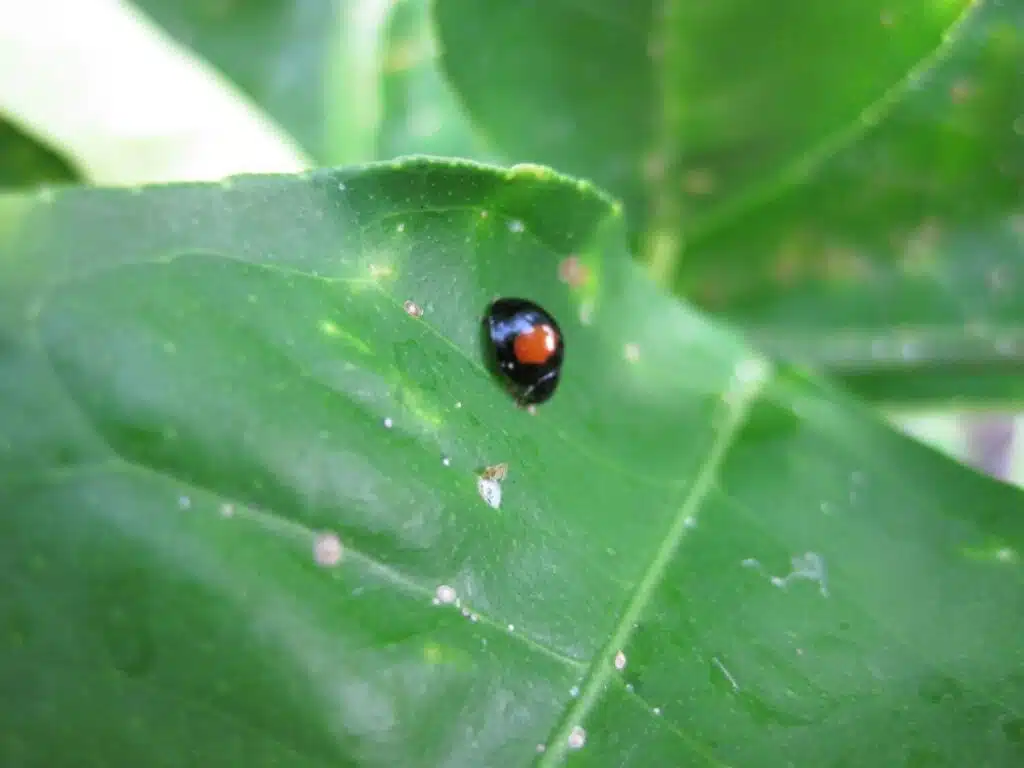
Scientific name: Chilocorus cacti
The Cactus Ladybug is one of the multiple predatory beetles of Texas.
This black beetle has 2 large red spots on its elytra which is why it may also be referred to as The Twice Stabbed Ladybeetles.
Scale insects are the main prey of the species. The attempts to use this beetle as a biological control agent weren’t all successful, however.
A typical small beetle, this species grows to 0.4 inches. It can be found in almost all areas with Prickly pear.
Distribution area – Central Texas, Southern Texas
29. Spotted Pink Ladybeetle

Scientific name: Coleomegilla maculata
A small beetle, the pink and black Spotted Pink Ladybeetle may reach a maximum length of 0.2 inches.
This is a species that lives throughout the state as it travels around crops and areas with insects it can feed on.
Spotted Pink Ladybeetles aren’t exclusively interested in insects as they also eat pollen and honeydew.
Some of the most common insects they feed on include mites and adelgids, commonly seen on pine.
The varied die of the species may still be scarce towards the end of the season. This is when The Spotted Pink Ladybeetle may also exhibit cannibalistic traits.
Distribution area – Northern Texas, Southern Texas, Central Texas
30. Grapevine Beetle

Scientific name: Pelidnota punctata
Bright brown color with or without black spots or marks is specific to The Grapevine Beetle.
Known as a problem for both cultivated grapes and wild grapes around the state, this is a species that feeds both on the grape fruits themselves and on grape leaves.
Their impact can be considerable in gardens and vineries.
Grapevine Beetle larvae are also known for their impact on the ecosystem as they can eat decaying wood.
Most larvae of the species are never far from grapes. They overwinter in the ground.
Distribution area – Eastern Texas
31. Black Caterpillar Hunter Beetle

Scientific name: Calosoma sayi
This type of beetle has a uniform black color. Both males and females have a black appearance without any spots or marks.
A common species along the Southern states, The Black Caterpillar Hunter Beetle overwinters in the ground before emerging in the spring.
It can live a long life as some of these beetles survive up to the third year.
The bug releases a foul smell when handled or when facing a potential predator. Its high speed may also help it make a quick escape.
Distribution area – Austin to Forth Worth
32. Rainbow Scarab

Scientific name: Phanaeus vindex
The Rainbow Scarab is a beetle named after its colorful appearance. This species has metallic green and dark brown coloring.
Rainbow Scarab Beetles are further known for their longhorn. Only males have horns and they use them to fight other males, often causing them injuries when establishing territoriality.
This species feeds on dung. It can be found around farms and wildlife. Swine dung is considered the most attractive to The Rainbow Scarab.
As a dung feeder, this type of scarab may also be a vector of parasites spread among swine and other animals.
Distribution area – Eastern Texas, Northern Texas
33. Big-headed Ground Beetle

Scientific name: Scarites subterraneus
Black color and an elongated head are the main physical traits of The Big-headed Ground Beetle.
This is a type of predatory bug that is also known for its fast speed.
One of the distinct traits of the species is having large front mandibles. These are used to grab prey such as small insects easier.
While an efficient predator, The Big-headed Ground Beetle rarely survives more than 1 year.
A typical adult measures slightly more than 1 inch including its long mandibles.
Distribution area – Eastern Texas
34. Black Blister Beetle

Scientific name: Epicauta pensylvanica
The Black Blister Beetle is a herbivorous species found on prairies and nearby disturbed lands.
It lives in areas with asters as it feeds on the pollen of these wildflowers.
These beetles come in a black uniform color or a striped form with yellow and black vertical stripes.
The species absorbs toxins from some of its most visited weeds and asters making them unpalatable to predators.
It can take up to 3 years for this species to complete its lifecycle.
Distribution area – Northern Texas
35. Banded Cucumber Beetle

Scientific name: Diabrotica balteata
One of the pests of crops in Southern Texas, Banded Cucumber Beetles grow to a maximum size of 0.3 inches.
This is a green species with yellow spots on its elytra.
Common in different types of crops, it tends to invade cucumber and squash crops the most. Beet, onions, and cabbages can also be impacted by the aggressive spread and feeding habits of the beetle.
Some of the proven management techniques against the species include spraying preventive insecticide just before their season starts in May.
Distribution area – Southern Texas
36. Emerald Flower Scarab

Scientific name: Trichiotinus lunulatus
The Emerald Flower Scarab has a metallic green color. Blue variants and green-brown variants of the species also exist around the state.
This type of beetle is herbivorous, feeding mostly on plant pollen.
While the adult of the species feeds on flowers, its larvae feed on decaying wood.
Known for appearing in a single generation per year, the beetle is active from spring to summer. It tends to live in vegetated areas around woodlands.
Distribution area – Dallas
37. Harlequin Flower Beetle

Scientific name: Gymnetis thula
The rare Harlequin Flower Beetle is mostly seen in Texas in North America. This is a species seen in different colors.
Yellow and black or green and black Harlequin Flower Beetles are among the most common in the state.
This is a species that feeds on plant and tree sap. It can feed on False willow and the sap of various oak trees around woodlands.
Adult beetles of this species can also feed on ripe and overripe fruit.
No considerable plant or tree damage has been reported when it comes to The Harlequin Flower Beetle
Distribution area – Southern Texas, Eastern Texas
38. Mealybug Destroyer

Scientific name: Cryptolaemus montrouzieri
A black and brown beetle, The Mealybug Destroyer is a species with white waxy larvae.
An introduced biological control agent, Mealybug Destroyers feed on various scale insects on citruses and in greenhouses.
Introduced in Texas a few decades ago, this species may also show cannibalistic traits in its larvae stage.
Distribution area – Eastern Texas, Southern Texas
39. Red-shouldered Bostrichid

Scientific name: Xylobiops basilaris
Mostly black color is characteristic of The Red-shouldered Bostrichid also shows 2 red spots.
The species is found around state woodlands. Deciduous tree woodlands are among its typical habitats in Texas.
This type of beetle is detrimental to a wide range of hardwood trees with falling leaves.
Red-shouldered Bostrichid beetles bore into healthy living trees and even into their branches. They prefer young trees where they can live from winter time.
Apart from feeding on trees, this species also bores into trees for shelter, especially towards the end of the year.
Distribution area – San Antoni, East Texas
40. Sesbania Clown Weevil

Scientific name: Eudiagogus pulcher
Black and pink colors dominate the appearance of The Sesbania Clown Weevil.
This type of weevil has a different pattern of contrasting stripes. Its pink and black stripes can sometimes be interrupted.
A rare type of Sesbania Clown Weevils has a yellow and black appearance.
This specie is mostly tied to areas around streams and rivers in the East as this is where Riverhemp grows.
Sesbania Clown Weevil only eats plants of the Riverhemp family.
Distribution area – Eastern Texas
41. Bumelia Borer

Scientific name: Plinthocoelium suaveolens
An emerald green color is characteristic of The Bumelia Borer. Beetles of this species also have very long black antennae and brown legs.
Once a common sight across the state, Bumelia Borers are now almost extinct from Southern Texas.
At least 8 subspecies of the borer can be found around the state, most with at least partial metallic green coloring or full metallic green coloring.
This species feeds on Bumelia genus trees. Its larvae feed on the roots of the tree.
Handling these bugs is safe but Bumelia Borers release defensive chemicals when disturbed.
Distribution area – Central Texas, Northern Texas
42. Sculptured Pine Borer

Scientific name: Chalcophora virginiensis
Southern Yellow Pines are among the typical hosts of The Sculpted Pine Borer.
This problematic species lay eggs in dead and decaying wood.
It lives on both solitary pine trees in parks and gardens as well around pine woodlands.
Gray and black body coloring is specific to this species. Multiple black stripes are seen across its elytra.
Distribution area – Davis Mountain Ranges
43. Yellow-margined Flower Buprestid

Scientific name: Acmaeodera flavomarginata
The Yellow-margined Flower Buprestid is a species named after its appearance. This species has bright yellow margins and a mainly black body.
A single orange or brown band may also be seen around the species. This band may or may not exhibit black spots.
Asters along the Southern counties of Texas are the most common food of the species which only eats pollen.
Distribution area – Southern Texas
44. Eight-spotted Flea Beetle

Scientific name: Omophoita cyanipennis
A common species in North America, The Eight-spotted Flea Beetle lives in the Southeastern and Southern counties of Texas.
This beetle is named after the 9 white spots on the black elytra of the species. A red band on the prothorax further contrasts its appearance.
The species eats all types of foods and it only overwinters in January.
Distribution area – Southern Texas
45. Red-headed Ash Borer

Scientific name: Neoclytus acuminatus
The Red-headed Ash Borer is a species with a red-brown body. It features chevron-shaped yellow or green marks along its body.
As its name implies, the borer feeds on ash. It is also spotted on various other trees such as hickory.
Unlike other borer bugs of Texas, The Red-headed Ash Borer only considers trees that have just died.
Its ecosystem impact is reduced as a result. Even more, these species help decompose dead trees in hardwood woodlands of the state.
Distribution area – Hill Country to San Antonio
46. Texas Soldier Beetle

Scientific name: Chauliognathus scutellaris
Much of the appearance of The Texas Solider Beetle is influenced by its host flowers. This species feeds on pollen from various wildflowers including asters.
A black and yellow contrasting appearance is characteristic of The Texas Solider Beetle. This is a species that has a black head and long yellow antennae.
Some of the ideal habitats of the species include protected areas as well as roadsides, and common areas where asters grow.
Distribution area – Rio Grande Valley State Park
47. Mesquite Borer
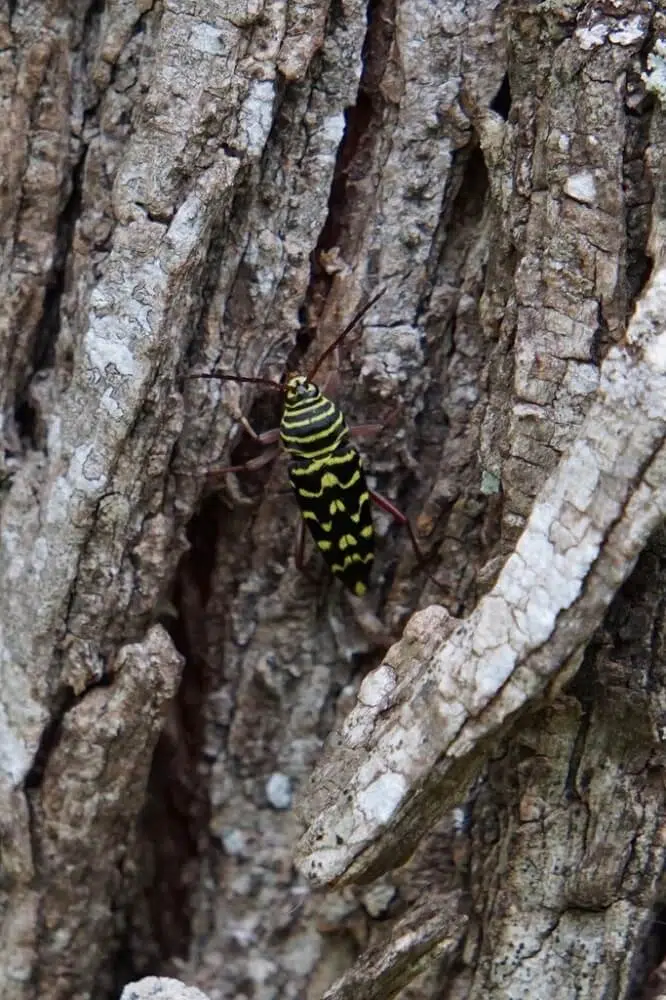
Scientific name: Placosternus difficilis
Found in many Texas counties except those in the West, Mesquite Borers have a contrasting dual-color body appearance.
This is a species that has a black base color with light green bands across the elytra and prothorax.
Feeding on mesquite and acacia, The Mesquite Borer is active until early October.
Active during the day, this borer may also be attracted to light at night. It also feeds on the rare Texas Crown of Thorns in the state’s Southwestern regions.
Distribution area – throughout the state
48. Polished Ladybug

Scientific name: Cycloneda munda
The Polished Ladybug is one of the smallest types of Texas Ladybugs.
Even adults of the species measure up to 0.2 inches or less.
A light brown or tan elytra is characteristic of the species. Black and white pronotums contrast its bright appearance.
A dome-shaped species, The Polished Ladybug can live around woodlands and on crops.
While small, it is a common predator of bugs that feed on crops such as alfalfa.
Distribution area – Eastern Texas
49. Southern Masked Chafer
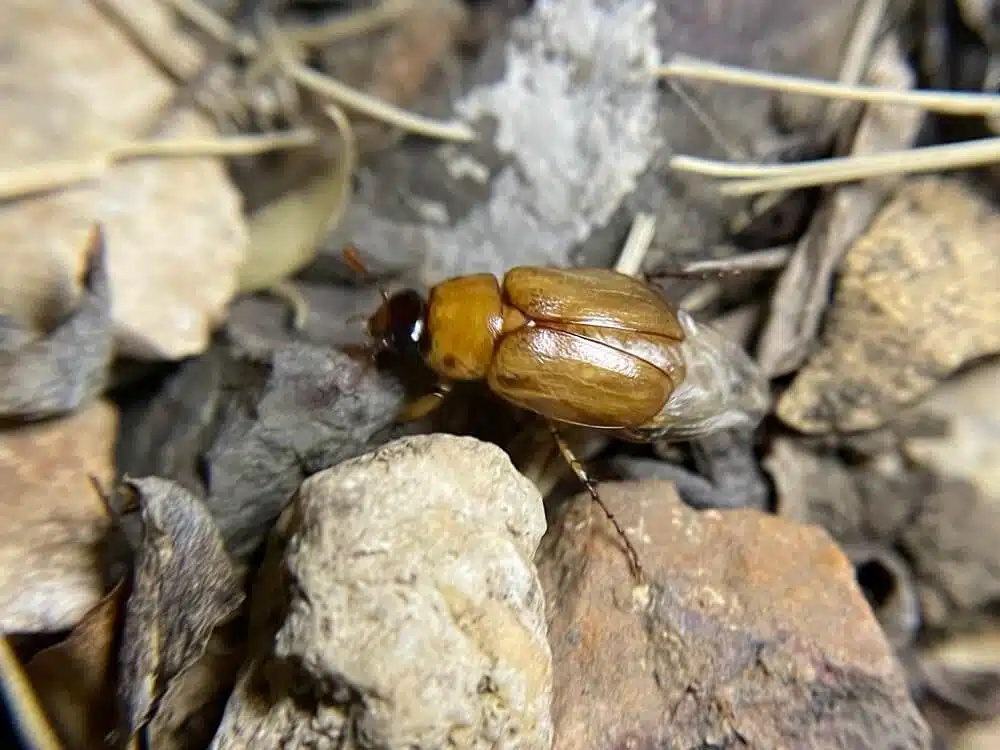
Scientific name: Cyclocephala lurida
One of the damaging types of beetles in Texas is represented by The Southern Masked Chafer. This is a species that has a light brown color and a black head.
Its presence is limited in the state since it likes grasses in high-moisture areas.
This is among the reasons why the Southern Masked Chafer is often found on lawns. While adults are harmless, their larvae feed on grassroots.
Distribution area – Eastern Texas
50. Robust Oak Borer

Scientific name: Enaphalodes atomarius
A black and gray or a black and yellow species, The Robust Oak Borer stands out with its long antennae which are even longer than its body.
Growing to a size of up to 0.7 inches, this species is also seen in an almost uniform black area in certain regions of Texas.
The trees it feeds on are believed to influence its appearance. These borers feed on hardwood trees.
Hackberry and hickory are among the typical hardwood species it feeds on.
Widespread in the Eastern part of the state, this species is more common in Central and South America.
Distribution area – Northeastern Texas, Southern Texas
51. Festive Tiger Beetle

Scientific name: Cicindela scutellaris
The Festive Tiger Beetle comes in various metallic colors and color combinations.
A metallic blue color is most specific to this beetle. Another blue and brown variant is also seen in the state. A rare form of the species has brown-red elytra and a green metallic prothorax.
A fast beetle, The Festive Tiger Beetle lives in sandy areas where it eats insects found on the ground.
It lives anywhere between 1 and 2 years.
Distribution area – South Texas
52. California Warrior Beetle
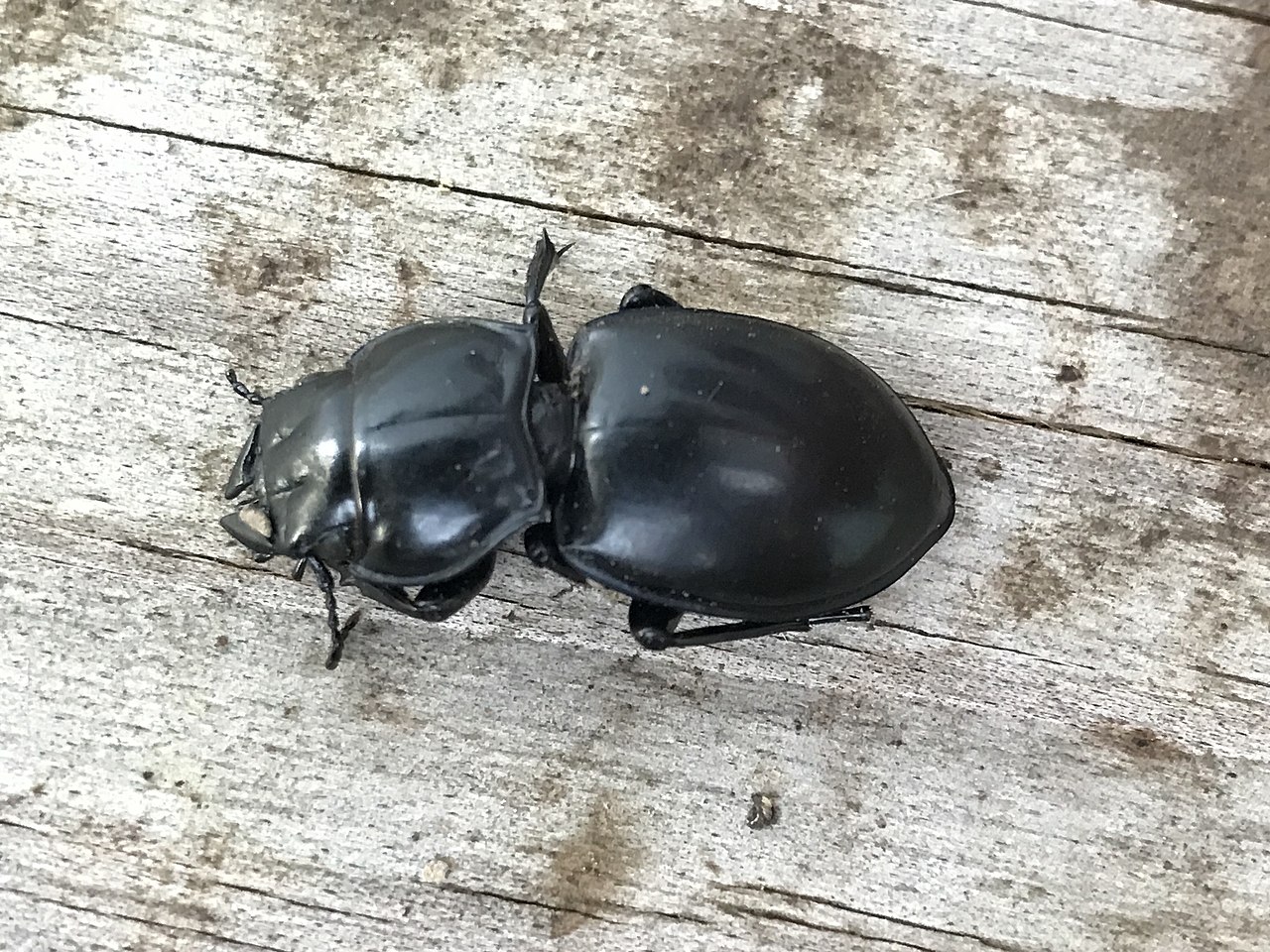
Scientific name: Pasimachus californicus
A species with elongated mandibles, The California Warrior Beetle has all-black coloring.
Growing to a size of around 1-2 inches, this species is an avid predator.
Humid locations such as leaf litter are among its ideal hunting territories. California Warrior Beetles may also hide under tree bark to escape the high temperatures during the day.
Distribution area – San Antonio to Dallas
53. Lesser Ivory-marked Beetle

Scientific name: Eburia mutica
Lesser Ivory-marked Beetles are rare borers in Texas. These bugs select dead wood to bore.
A light brown appearance is specific to the species. Lesser Ivory-marked Beetles also have antennae longer than their bodies.
While it bores into different trees, Lesser Ivory-marked Beetles are mostly found in Texas ebony, a local evergreen tree.
Distribution area – Corpus Christi
54. Twice-stabbed Ladybug

Scientific name: Chilocorus stigma
The Twice-stabbed Ladybug is less common or not as active as other types of ladybugs in Texas.
Ladybugs of this genus have a round dome shape and 2 large red or orange spots on the elytra.
It is believed these large spots act as warning signs to potential predators such as birds.
Scale insects, aphids, and mealybugs are the types of species Twice-stabbed Ladybugs eat.
Some of the regions where these types of insects are found by the ladybug include oak and pine woodlands.
Distribution area – Dallas to San Antonio